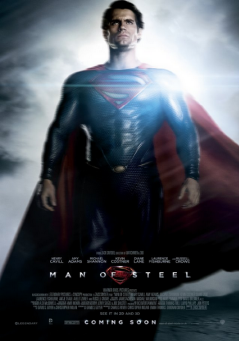By Jeremy Hannaford (Contributor) – Email
Print Edition: June 19, 2013
 When you hear Jonathan Kent tell his young son Clark that he needs to keep his powers secret, even if he has to let people die, you know you aren’t in the same Smallville you once knew. The idea of the lone Kryptonion going against his instinct and hiding his true self from the world is a new and intriguing interpretation of the fabled hero. It’s a shame that Man of Steel doesn’t live up to this standard.
When you hear Jonathan Kent tell his young son Clark that he needs to keep his powers secret, even if he has to let people die, you know you aren’t in the same Smallville you once knew. The idea of the lone Kryptonion going against his instinct and hiding his true self from the world is a new and intriguing interpretation of the fabled hero. It’s a shame that Man of Steel doesn’t live up to this standard.
From the first trailers, we were teased with the idea of a reclusive Superman – a man with untold power who is afraid to show himself in fear of how he will be persecuted by mankind. And it is a focus of the film, all too brief perhaps, but it is there. Man of Steel does feel like a new experience in the history of the character. After an eventful opening on Krypton with Jor-El sending his son away from the dying planet, the film travels into the future with Kal-El/Clark Kent (Henry Cavill) as a young man drifting from one life to another.
With a running time of two-and-a-half hours, a majority of this time is felt in first act. While we see Kal-El perform small feats of strength and heroism only to disappear into shadow, we don’t see him actually commit to being a hero for nearly half the film. This story arc is the true gold of the story. While he hides amongst the broken and downhearted, we see glimpses of his childhood through flashbacks that establish why he hides his true self. A small boy hiding from the noises of the world that fill his ears was the beginning of what this film could have been. With such untold power, how would a child be able to control it? And even if he could, would he still want such power? Before these points can be defined though, the film returns to the present day, leaving an opportunity half spent.
Instead we are given a barrage of amazing fight sequences in the third act that just keep coming. The intensity of Kal-El’s fury that he has hidden so well throughout his life is unleashed in the final confrontations. These sequences are incredible to watch but it seems that director Zack Snyder kept saying to himself, “We can destroy a few more buildings.” The destruction is what you would expect of a modern day Superman film. With the help of Weta Digital, the effects are crisp and beautiful but they start to take over the film and the story sits on the sideline while super aliens fight each other. There were moments that the true conflict of ideologies and commitments could have come to the forefront; but while they are present, you are always left feeling that it could have been better.
Snyder has shown that his best work (the Dawn of the Dead remake, Watchmen) has been reliant on heavy source material. Trying to make stuff out of thin air has proven to be troublesome and unorganized, as with his last film Sucker Punch. With Man of Steel, Snyder tries to right his wrongs and bring a new vision of Superman to the screen. He even sacrifices his trademark slow motion for the sake of the film. But unfortunately, it isn’t enough to fix the holes left by David S. Goyer’s script. Goyer has proven time and again that he has interesting ideas for comic book films, but his execution borderlines on disaster. The Dark Knight films were great because Christopher Nolan was always part of the writing team and would stop Goyer going off the rails and losing focus. While Nolan is a producer on the film, Goyer goes unchecked, taking the story’s pacing with him.
While the story is weaker than it could have been, Man of Steel is an aesthetically amazing blockbuster. With a great performance from Cavill, the character of Kal-El still has his all-American grassroots but also a side of humility and fear that was absent from the previous films. Along with a great soundtrack from Hans Zimmer, Man of Steel is sure to entertain you but you will keep thinking about how much of a better story it could have been.

